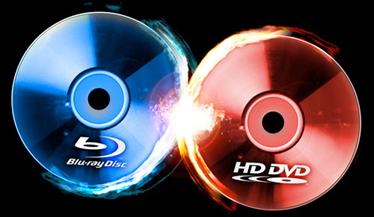|
|
Intermittent Issues:
|

|
HD-DVD had the stronger start initially; sales were acceptably good, if slower than the comparable period during DVD’s launch: at the end of 2006, 120,000 dedicated HD-DVD players had been sold, compared to 25,000 dedicated Blu-ray players. Early Blu-ray players were also affected by slow loading times, expected read errors, and a stupendously high price tag (the first dedicated player, the Samsung BD-P1000, cost $1,000 at launch, while the first HD-DVD player from Toshiba cost half as much and presented no unique read errors or speed issues; back in the quaint old days of 1998, a new DVD player averaged about $350).New at BOP: Share & Save
![]() Tweet
Tweet
![]() Print this column
Print this column
Despite these early figures, the tide had turned in favor of Blu-ray only a few months after its introduction, although this wasn’t readily apparent at the time and HD-DVD production continued throughout 2007 and into 2008. The exact date of Blu-ray’s change in fortune was November 17, 2006, when Sony’s PlayStation 3 was released in North America. Microsoft’s competing console, the XBox 360, had been released the previous year; while an HD-DVD drive was offered for the 360 in 2006, it didn’t take off to the same degree. Sales of the HD-DVD drive add-on reached 150,000 units by the end of 2006; by comparison, sales of the PlayStation 3 hit nearly three times that number, with 400,000 sold through the same period. By virtue of the PlayStation 3 acting as a Trojan horse for the Blu-ray format, the user base now tilted heavily out of HD-DVD’s favor; there were 270,000 HD-DVD units in homes by the end of 2006, versus 425,000 Blu-ray units.
|
Advertisement |
Around the end of 2006, Sony also got a handle on the major issues the Blu-ray format had faced at launch: discs were starting to be created with the AVC and VC-1 codecs, and a lab had finally developed a protective polymer coating for the Blu-ray disc that was simultaneously thin enough to be read through and yet harder than the protective coatings on DVDs or HD-DVDs. This enabled the pressing and production of dual-layer Blu-rays without the fear that a slight mishandling would damage the data. Finally, the Blu-ray player quality took a sizable step upward with the introduction of the PlayStation 3; not only was the console by far the most powerful of its generation, but the HD connectivity options and operational reliability of the Blu-ray drive were significantly more streamlined. It also helped that the best Blu-ray player on the market was launched at a price point between $500 and $600 - comparable to the initial HD-DVD players and significantly lower than the Samsung standalone Blu-ray player.
At the start of 2007, both formats were on roughly equal footing. Blu-ray had more studios supporting its format than HD-DVD did (having initially started with the exclusive support of Columbia Pictures, Walt Disney Pictures, and 20th Century Fox, Blu-ray gained support from Paramount and Warner Bros., which had previously been exclusive to HD-DVD), but the libraries for both formats were continuing to grow, and retailers continued to stock and advertise both formats.
[ Email this column ]

|
|
|

|
Friday, April 19, 2024
© 2024 Box Office Prophets, a division of One Of Us, Inc.

